InGaAs Multi-quantum well laser diode
Header
- Files for the tutorial located in nextnano++\examples
LaserDiode_InGaAs_1D_cl_nnp.in
LaserDiode_InGaAs_1D_qm_nnp.in
Introduction
In this tutorial, we simulate optical emission of a 1D InGaAs multi-quantum well laser diode grown on InP substrate. The blue region, seen in Figure 2.4.88, is the separate confinement heterostructure (SCH), which forms an optical waveguide in the transverse direction to confine the emitted light (red arrow). The multi-quantum wells and SCH are clad by InP on both sides. A voltage bias is applied to the gray edges.
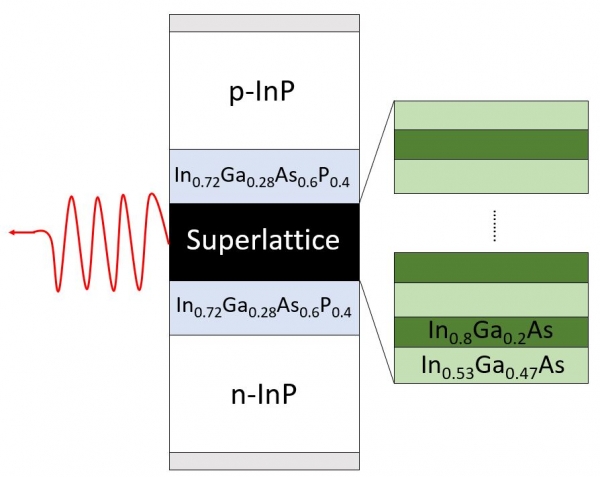
Figure 2.4.88 Structure overview
Current equation
The properties of optoelectronic devices are governed by Poisson
equation, Schrödinger equation, drift-diffusion and continuity
equations. We denote by
where the current is proportional to the gradient of quasi Fermi levels
Here the charge current has the unit of
(area)
which we call
current equation (generation
run{
current_poisson{ }
}
Recombination of carriers and emission spectrum
The generation/recombination rate,
Schockley-Read-Hall recombination
Auger recombination
radiative recombination
Each mechanism can be turned on and off in the input file.
Radiative recombination describes the recombination of electron-hole
pairs at a position
where
In nextnano++, this radiative recombination whose rate is calculated as above is regarded as spontaneous emission. On the other hand, the net amount of the stimulated emission rate is given by:
This is consistent with eq.(9.2.39) in [ChuangOpto1995]. We note that here it is assumed that photon modes occupied by one photon each, i.e. takes into account neither energy-dependent photon density of states nor Bose-Einstein distribution.
Since the radiative recombination process involves no phonons, this transition is vertical and therefore this contribution is only relevant for semiconductors with a direct band gap such as GaAs.
Absorption coefficient is calculated from
where
Input file
In the beginning of the input file, we define several variables for the structure and parameters for simulation. The variable definitions are shown in Figure 2.4.89.

Figure 2.4.89 The definition of variables. The gray regions are contacts of 1nm thickness.
$NUMBER_OF_WELLS determines the repetition of quantum wells.
The program automatically sweeps the bias voltage starting from
$BIAS_START until $BIAS_END, at intervals of
$BIAS_STEPS.
Charge density as a function of position
grid{
...
energy_grid{
min_energy = -1.5 # Integrate from
max_energy = 0.5 # Integrate to
energy_resolution = 0.005 # Integration resolution
}
}
classical{
...
energy_distribution{ # Calculation of carrier densities as a function of energy
min_energy = -1.5 # Integrate from
max_energy = 0.5 # Integrate to
energy_resolution = 0.005 # Integration resolution
only_density_quantum_regions = yes
}
energy_resolved_density{
only_density_quantum_regions = yes
output_energy_resolved_densities{}
}
semiclassical_spectra{
output_spectra{
emission = yes
gain = yes
absorption = yes
spectra_over_energy = yes
spectra_over_wavelength = yes
spectra_over_frequency = yes
spectra_over_wavenumber = yes
photon_spectra = yes
power_spectra = yes
}
output_photon_density = yes
output_power_density = yes
}
}
The mobility model and recombination models for the current equation are specified in currents{ } as
currents{
mobility_model = constant
# mobility_model = minimos
recombination_model{
SRH = yes # 'yes' or 'no'
Auger = yes # 'yes' or 'no'
radiative = yes # 'yes' or 'no'
}
}
The run{ } flag specifies which equations to solve.
This is the main difference between LaserDiode_*_qm_nnp.in and LaserDiode_*_cl_nnp.in.
# qm
run{
strain{ } # solves the strain equation
current_poisson{ # solves the coupled current and Poisson equations self-consistently
output_log = yes
iterations = 1000
alpha_fermi = 0.5
}
quantum_current_poisson{ # solves the Schrödinger, Poisson (and current) equations self-consistently
iterations = 1000
alpha_fermi = 0.9
residual = 1e6
residual_fermi = 1e-8
output_log = yes
}
}
# cl
run{
strain{ } # solves the strain equation
current_poisson{ # solves the coupled current and Poisson equations self-consistently
output_log = yes
iterations = 1000
alpha_fermi = 0.7
residual_fermi = 1e-10
}
}
In this case nextnano++ first solves the strain equation from the
crystal orientation to decide the polarization charges (piezoelectric
effect) and shifted band edges. Then the program solves the coupled
current-Poisson-Schrödinger equations in a self-consistent way (input
file: LaserDiode_InGaAs_1D_qm_nnp.in). For the classical calculation
(LaserDiode_InGaAs_1D_cl_nnp.in), quantum_current_poisson{ } is commented out to restrict the
calculation to the current-Poisson equations only.
Results
Band structure
The band structure and emission power spectrum of the system are stored in bandedges.dat.
Figure 2.4.90 shows the case for the bias
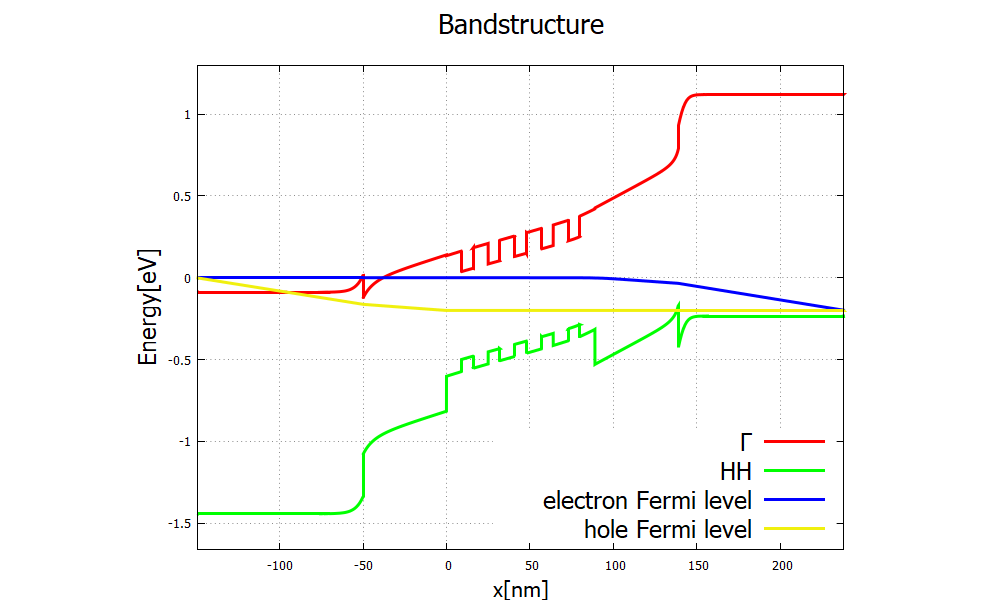
Figure 2.4.90 Band structure of the laser diode system for a low bias of
For the bias \Optical\emission_photon_density.dat,
one can see that the photons are emitted from this active region (not shown).
Figure 2.4.99 shows the emission spectrum in this case. When the bias is too small,
e.g. Figure 2.4.90, the intensity is much smaller, as can be seen in Figure 2.4.103.
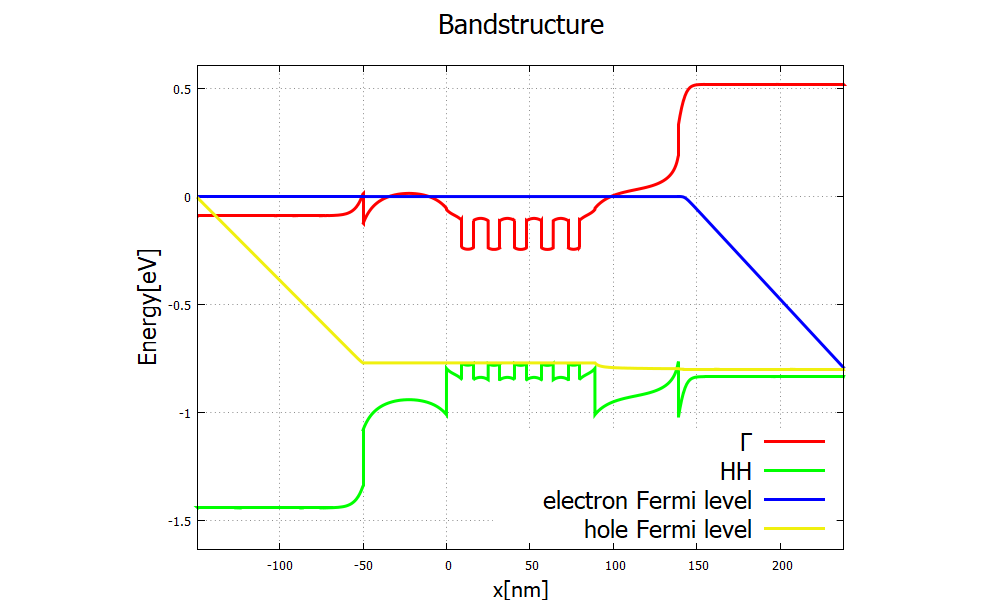
Figure 2.4.91 Band structure for a high bias
Energy eigenstates and eigenvalues
In the input file LaserDiode_InGaAs_1D_qm_nnp.in, the single-band Schrödinger equation is coupled
to the current-Poisson equation and solved self-consistently.
The wave functions of electrons and holes along with eigenvalues are written in
\Quantum\probabilities_shift_quantum_region_Gamma_0000.dat and
\Quantum\probabilities_shift_quantum_region_HH_0000.dat (Figure 2.4.92 and Figure 2.4.93).
The light hole and split-off states are out of the quantum wells and not of our interest here.
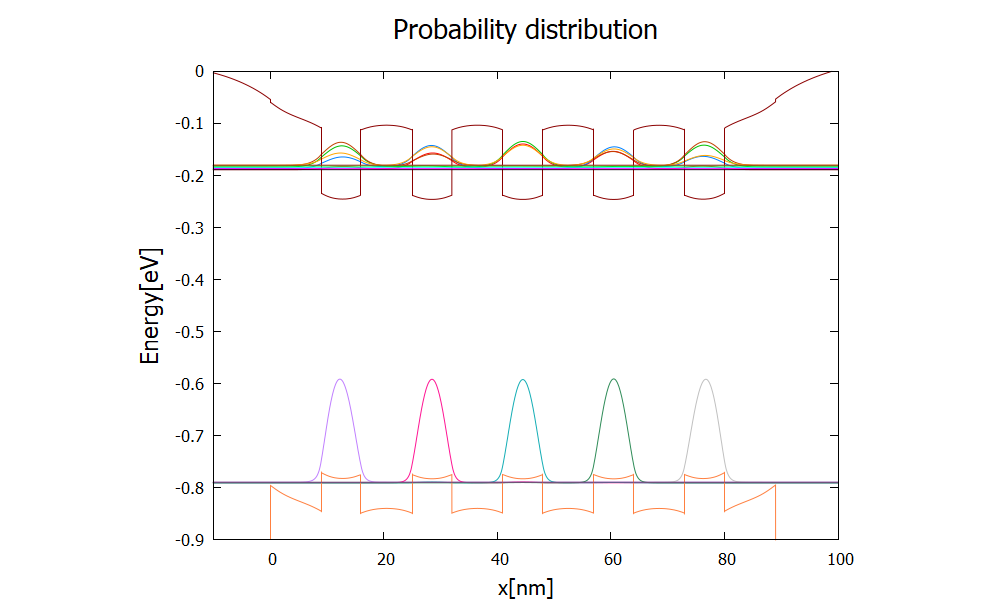
Figure 2.4.92 Probability distribution
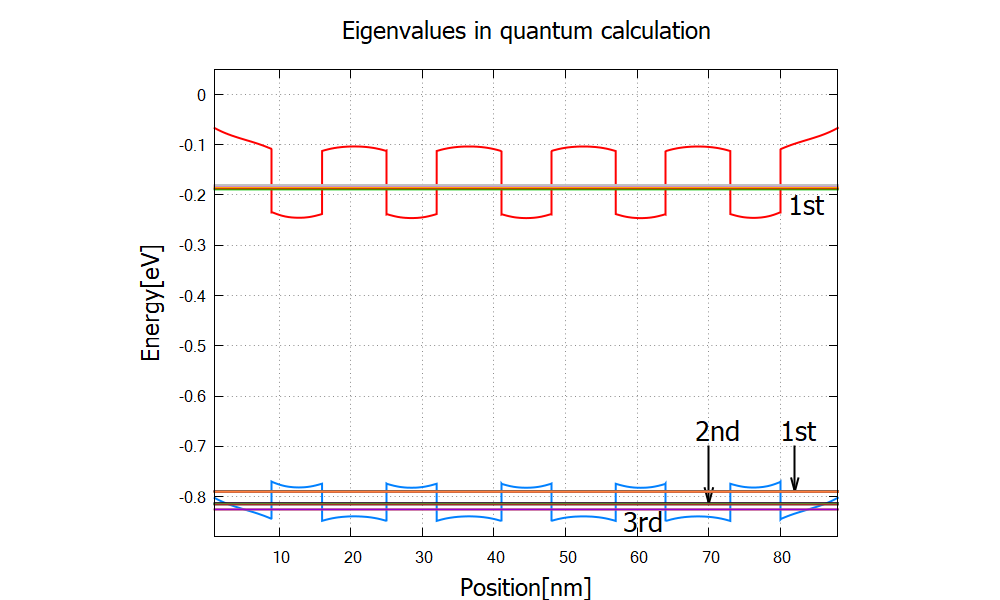
Figure 2.4.93 Eigenvalues of the Gamma-band up to 5th and heavy-hole-band states up to 13th in relation to band edges. The Eigenvalues above these are higher than the barrier energy of the quantum wells. The Gamma band has single “miniband”, whereas the heavy-hole band has three. The 1st heavy-hole miniband consists of the 1st~5th eigenvalues, the 2nd heavy-hole miniband consists of the 6th~11th eigenvalues and the 3rd consists of the 12th and 13th eigenvalues.
Charge densities
We can find the energy-resolved charge density electron_density_vs_energy.fld and hole_density_vs_energy.fld.
The following figures represent
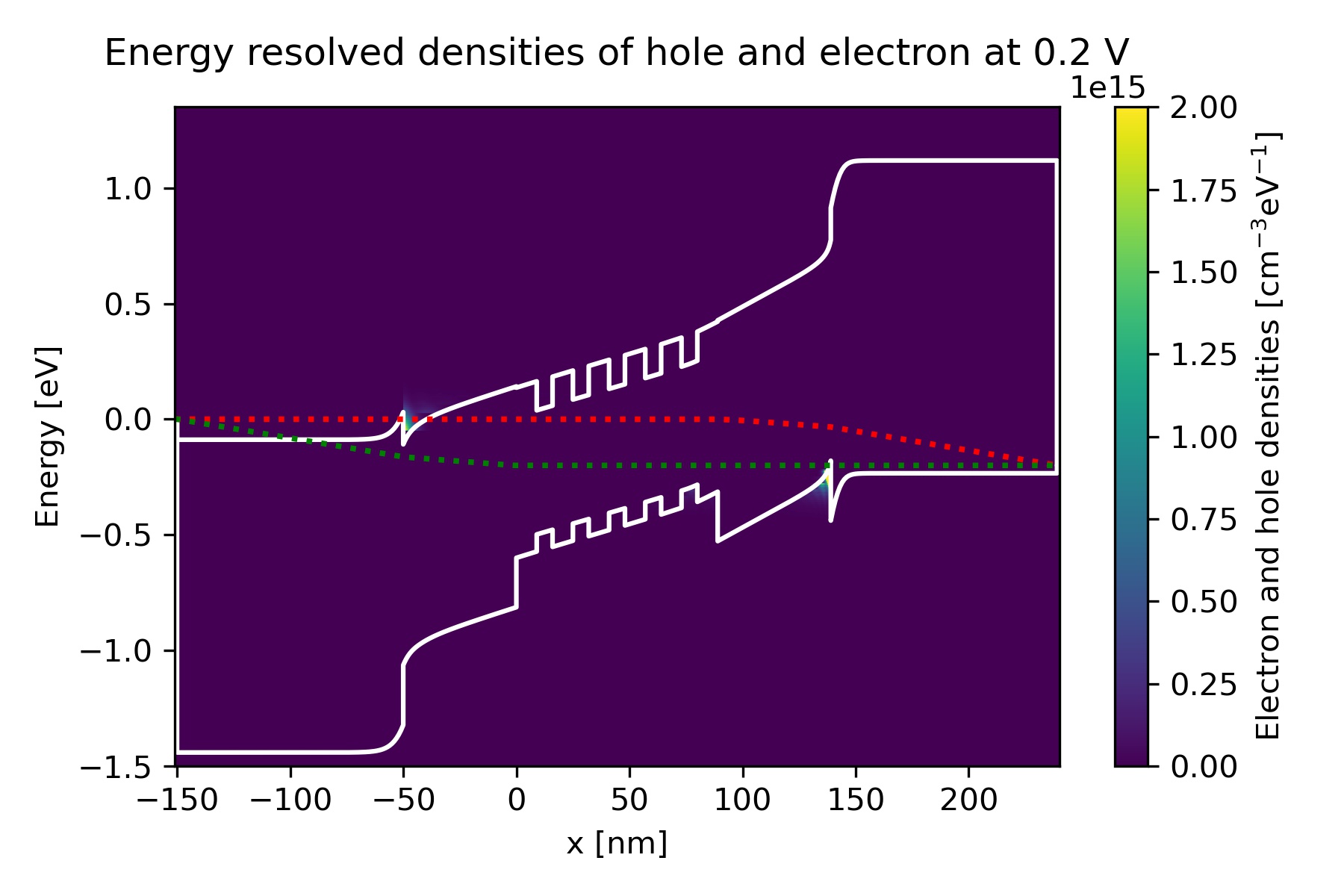
Figure 2.4.94 Energy-resolved electron and hole density, Gamma conduction band edge, HH valence band edge and quasi-Fermi levels at bias 0.2 V in quantum calculation.
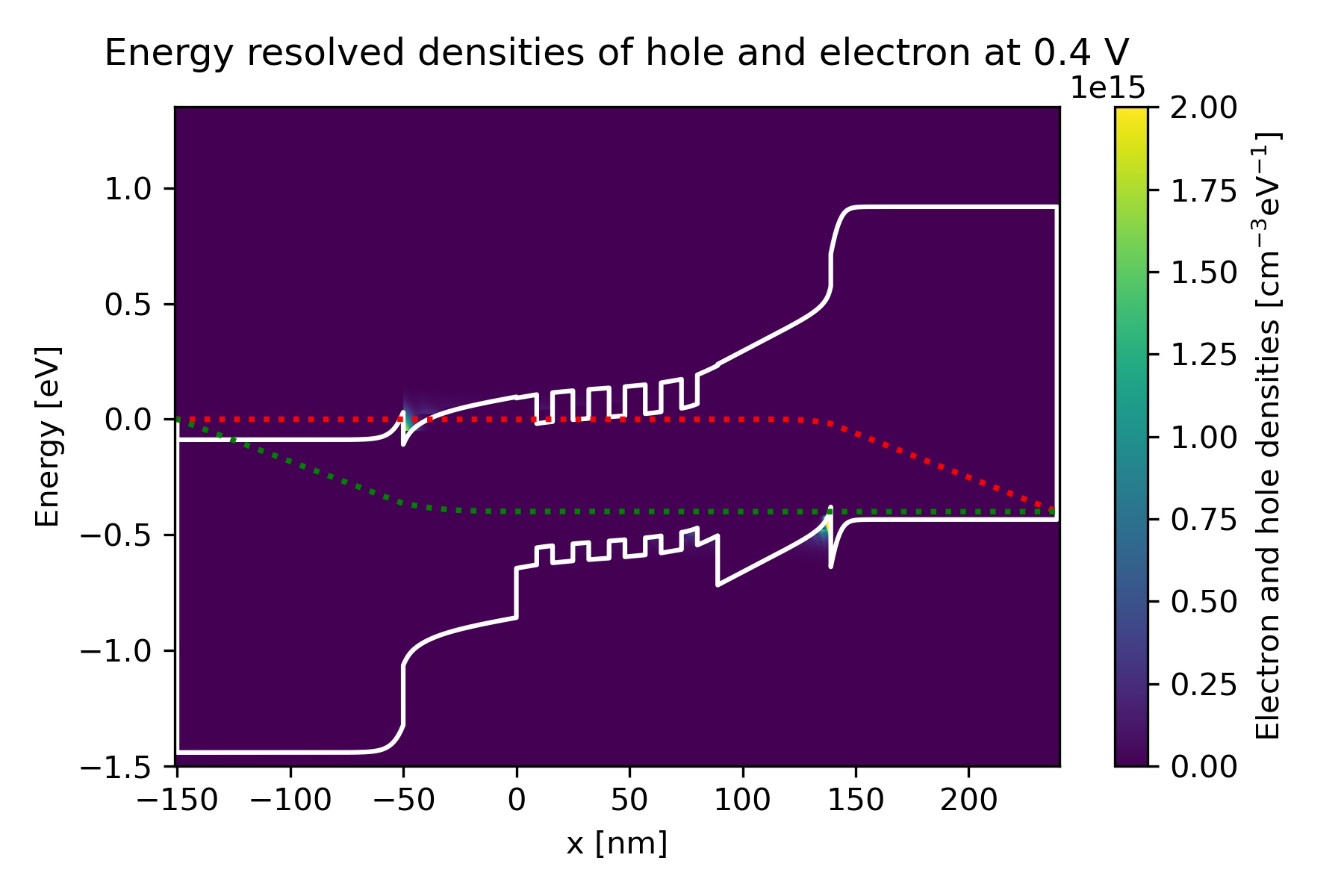
Figure 2.4.95 Energy-resolved electron and hole density, Gamma conduction band edge, HH valence band edge and quasi-Fermi levels at bias 0.4 V in quantum calculation.
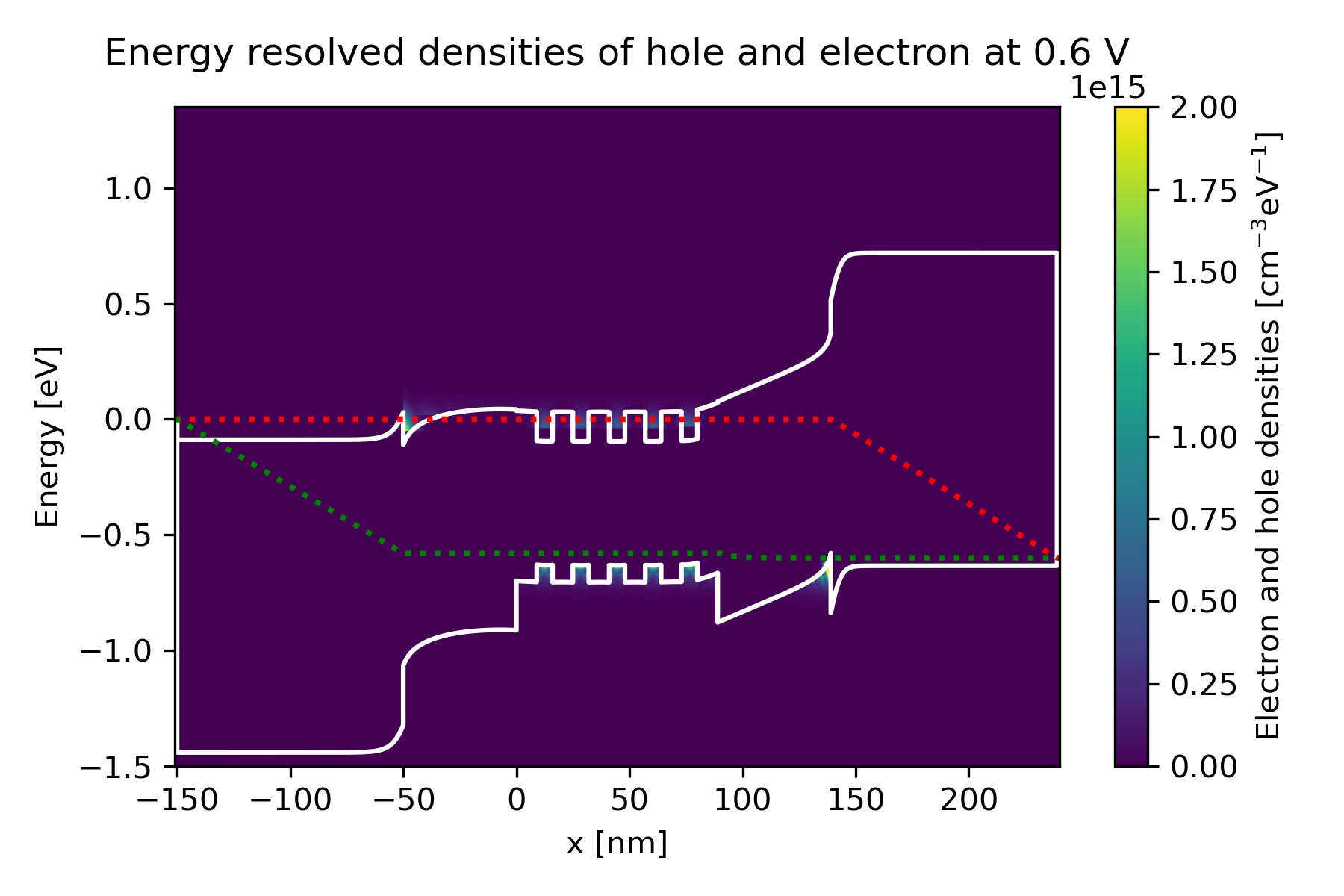
Figure 2.4.96 Energy-resolved electron and hole density, Gamma conduction band edge, HH valence band edge and quasi-Fermi levels at bias 0.6 V in quantum calculation.
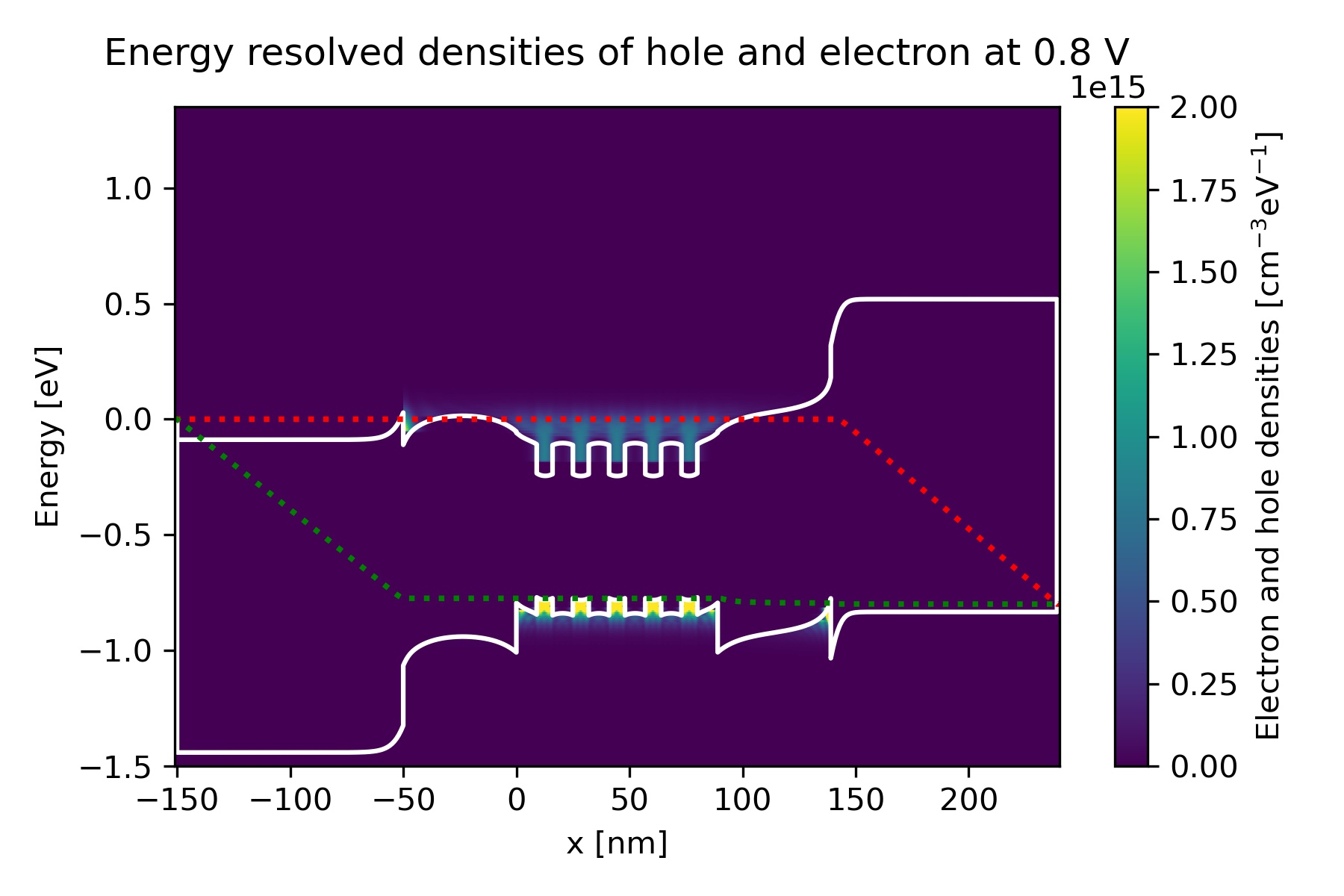
Figure 2.4.97 Energy-resolved electron and hole density, Gamma conduction band edge, HH valence band edge and quasi-Fermi levels at bias 0.8 V in quantum calculation.

Figure 2.4.98 Energy-resolved electron and hole density, Gamma conduction band edge, HH valence band edge and quasi-Fermi levels at bias 1.0 V in quantum calculation.
Note
These graphs are generated by nextnanopy.
We also have the charge densities integrated over the device
integrated_densities_vs_energy.dat.
Figure 2.4.99 illustrates the population inversion in stationary (quasi-equilibrium) state of the device under bias. Solid and dashed lines are for quantum and classical calculations, respectively. The black arrows mark the relevant energies of the structure 4 at bias of 0.8 V. The hole density is shown in Figure 2.4.100 with higher resolution.
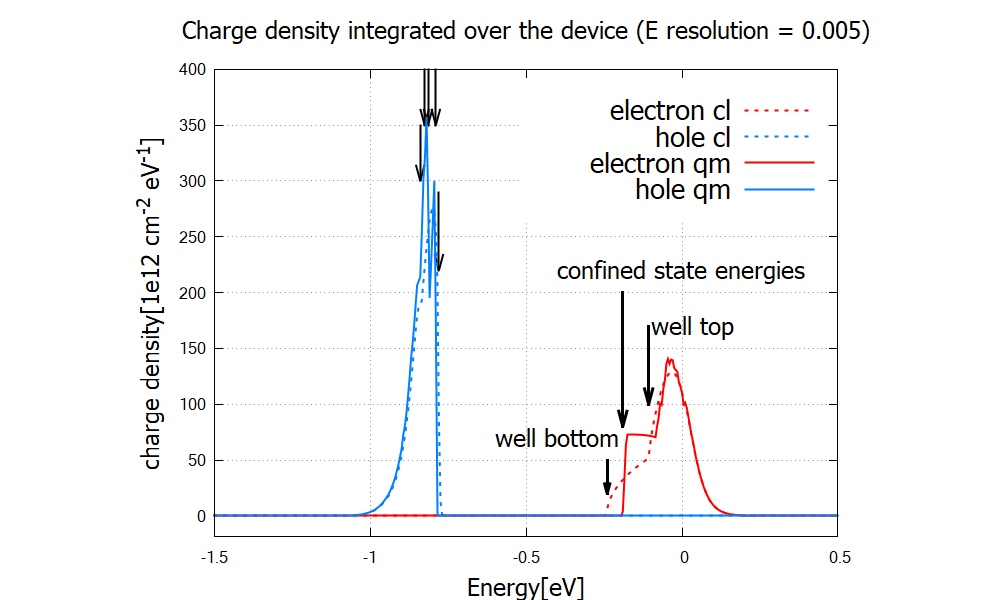
Figure 2.4.99 Electron (red) and hole (blue) densities integrated over the device as a function of energy.
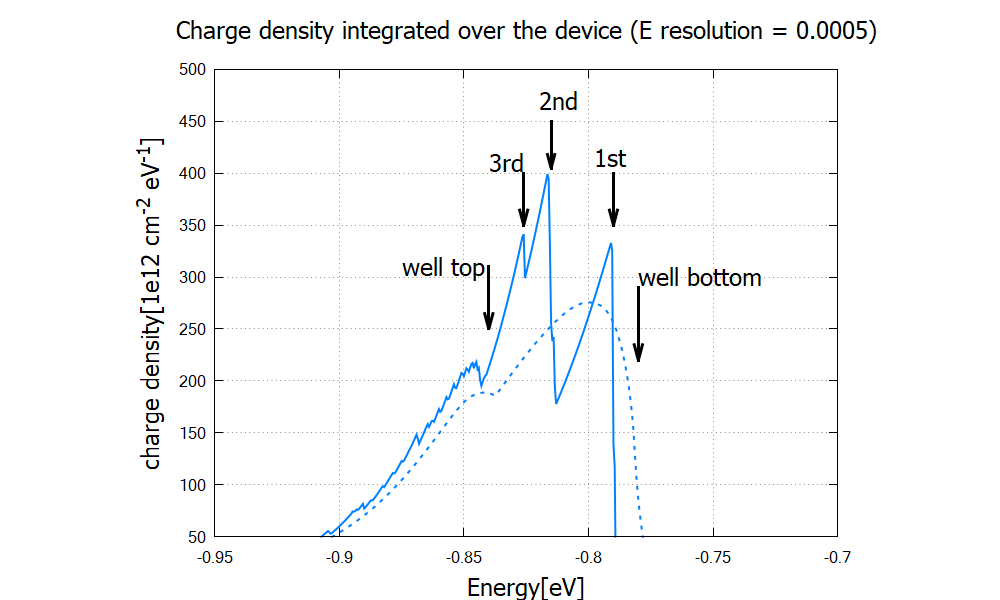
Figure 2.4.100 Hole density integrated over the device from classical (dashed) and quantum (solid) calculation.
The energy resolution in Figure 2.4.100 has been increased by a factor of 10 from Figure 2.4.99.
Note
Although these charge densities either with variable
Emission and absorption spectra
The spontaneous and stimulated emission spectra are written in
\Optical\semiclassical_spectra_photons.dat and
\Optical\stim_semiclassical_spectra_photons.dat, respectively (Figure 2.4.101).
The peak is at around 0.7-0.8eV, which is consistent with the charge distribution in Figure 2.4.99.
The stimulated emission does not occur above the quasi Fermi level separation,
The formulas used for the calculation in the source code are specified above: Recombination of carriers and emission spectrum.
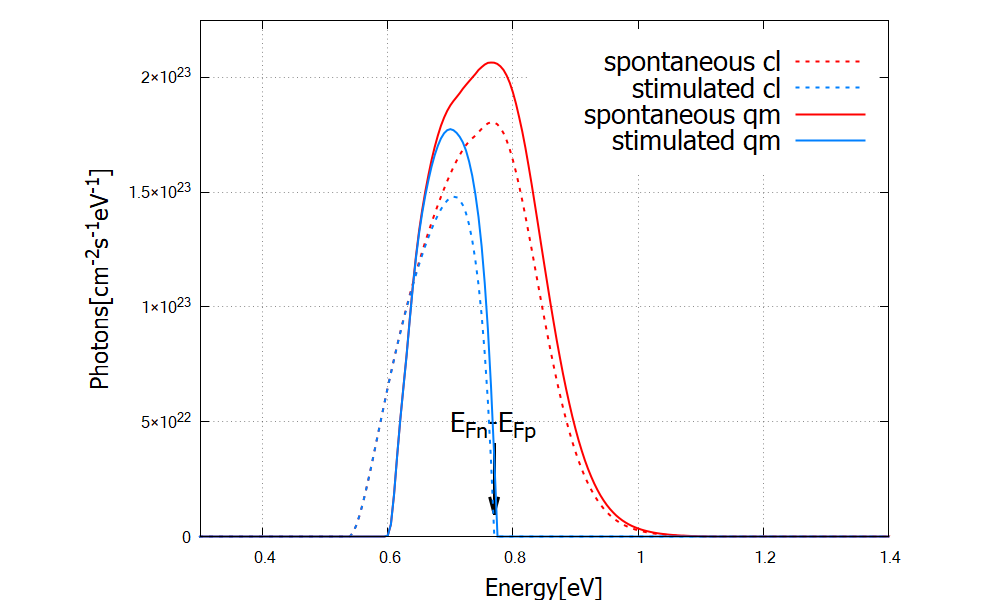
Figure 2.4.101 Emission spectrum of the laser diode for the bias
The absorption spectra are calculated as
where
The absorption spectra
These are by definition independent of the initial photon population. Please note that the gain spectrum in nextnano++ is cut off where it is negative. For details, see classical{ }.
The spectrum changes its sign at the energy bandedges.dat, this value is -0.0001-(-0.7702)=0.7701eV. The
following result has been calculated classically. We also get
qualitatively consistent results from quantum mechanical simulation.
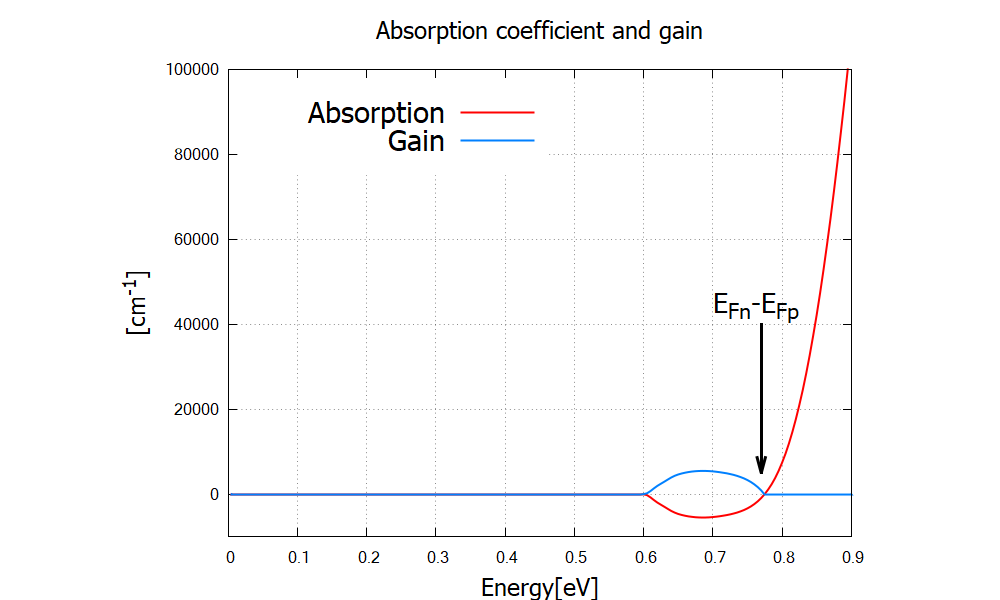
Figure 2.4.102 Classically calculated absorption and gain spectra. The sign of the spectrum switches at the energy corresponding to the quasi Fermi-level separation in the active region.
Current and internal quantum efficiency
The output file IV_characteristics.dat contains right- and left-contact current in unit of [Acm
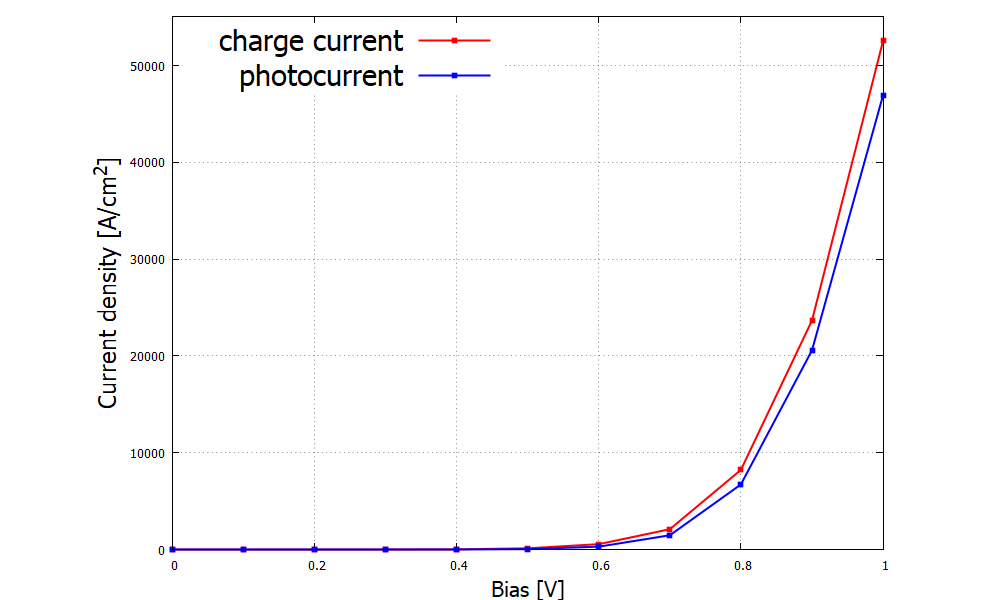
Figure 2.4.103 Charge current and photocurrent as a function of bias voltage (IV characteristics).
Figure 2.4.103 clearly shows the consequence of the difference in band structures Figure 2.4.90 and Figure 2.4.91. The holes and electrons recombine in the multi-quantum well layers, emitting one photon per electron-hole pair. The efficiency of conversion from charge current into photocurrent is called the internal quantum efficiency
This quantity is written in internal_quantum_efficiency.dat and shown in Figure 16.
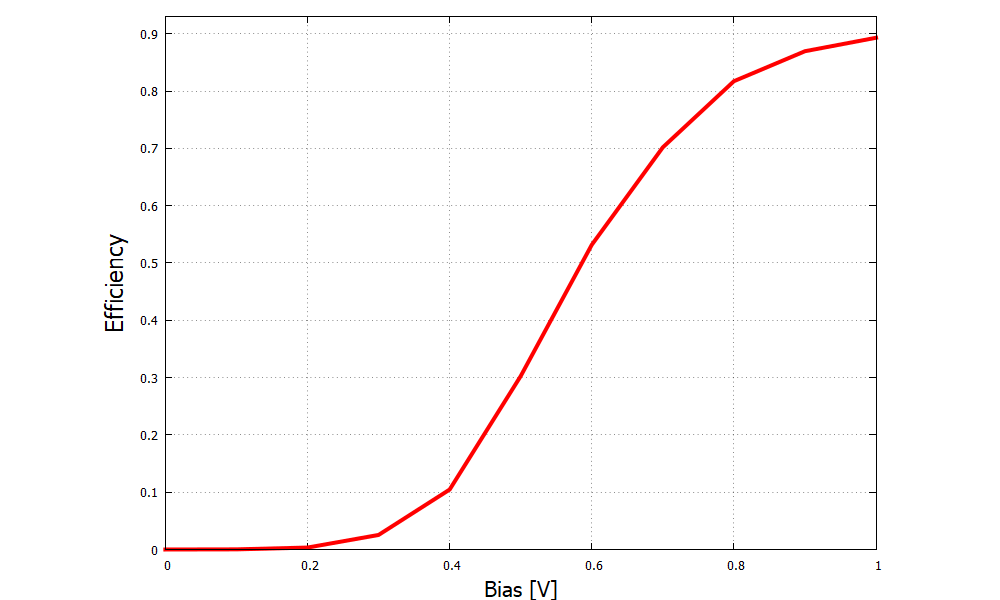
Figure 2.4.104 Conversion efficiency of the InGaAs laser diode.
Last update: 16/07/2024